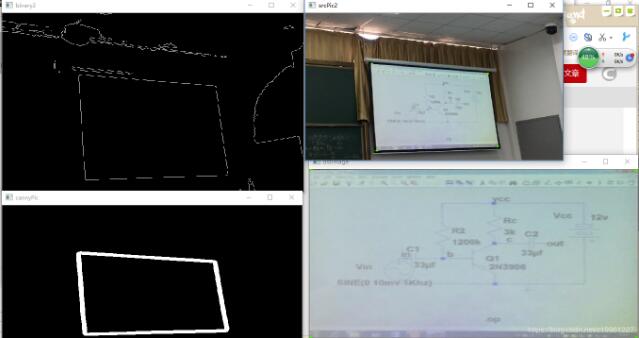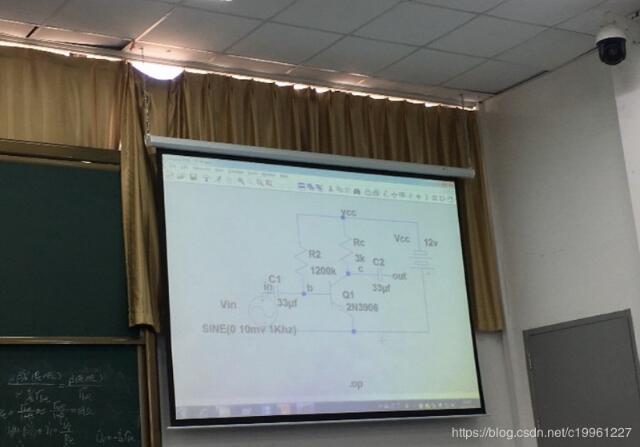改编自详解利用OpenCV提取图像中的矩形区域(PPT屏幕等) 原文是c++版,我改成了python版,供大家参考学习。
主要思想:边缘检测—》轮廓检测—》找出最大的面积的轮廓—》找出顶点—》投影变换
|
1
2
3
4
5
6
7
8
9
10
11
12
13
14
15
16
17
18
19
20
21
22
23
24
25
26
27
28
29
30
31
32
33
34
35
36
37
38
39
40
41
42
43
44
45
46
47
48
49
50
51
52
53
54
55
56
57
58
59
60
61
62
63
64
65
66
67
68
69
70
71
72
73
74
75
76
77
78
79
80
81
82
83
84
85
86
87
88
89
90
91
92
93
94
95
96
97
98
99
100
101
102
103
104
105
106
107
108
109
110
111
112
113
114
115
116
117
118
119
120
121
122
123
124
125
126
127
128
129
130
131
132
133
134
135
136
137
138
139
140
141
142
143
144
145
146
147
148
149
150
|
import numpy as npimport cv2# 这个成功的扣下了ppt白板srcPic = cv2.imread('2345.jpg')length=srcPic.shape[0]depth=srcPic.shape[1]polyPic = srcPicshrinkedPic = srcPicgreyPic = cv2.cvtColor(shrinkedPic, cv2.COLOR_BGR2GRAY)ret, binPic = cv2.threshold(greyPic, 130, 255, cv2.THRESH_BINARY)print(binPic.shape)median = cv2.medianBlur(binPic, 5)# 进行边缘检测cannyPic = cv2.Canny(median, 10, 200)cv2.namedWindow("binary", 0)cv2.namedWindow("binary2", 0)cv2.imshow("binary", cannyPic)# 找出轮廓contours, hierarchy = cv2.findContours(cannyPic, cv2.RETR_CCOMP, cv2.CHAIN_APPROX_SIMPLE)cv2.imwrite('binary2.png', cannyPic)cv2.imshow("binary2", cannyPic)i = 0maxArea = 0# 挨个检查看那个轮廓面积最大for i in range(len(contours)): if cv2.contourArea(contours[i]) > cv2.contourArea(contours[maxArea]): maxArea = i#检查轮廓得到分布在四个角上的点hull = cv2.convexHull(contours[maxArea])s = [[1,2]]z = [[2,3]]for i in hull: s.append([i[0][0],i[0][1]]) z.append([i[0][0],i[0][1]])del s[0]del z[0]#现在的目标是从一堆点中挑出分布在四个角落的点,决定把图片分为四等份,每个区域的角度来划分点,#默认四个角分别分布在图像的四等分的区间上,也就是矩形在图像中央# 我们把所有点的坐标,都减去图片中央的那个点(当成原点),然后按照x y坐标值的正负 判断属于哪一个区间center=[length/2,depth/2]# 可以得到小数for i in range(len(s)): s[i][0] = s[i][0] - center[0] s[i][1] = s[i][1] - center[1]one = []two = []three = []four = []# 判断是那个区间的for i in range(len(z)): if s[i][0] <= 0 and s[i][1] <0 : one.append(i) elif s[i][0] > 0 and s[i][1] <0 : two.append(i) elif s[i][0] >= 0 and s[i][1] > 0: four.append(i) else:three.append(i)p=[]distance=0temp = 0# 下面开始判断每个区间的极值,要选择距离中心点最远的点,就是角点for i in one : x=z[i][0]-center[0] y=z[i][1]-center[1] d=x*x+y*y if d > distance : temp = i distance = dp.append([z[temp][0],z[temp][1]])distance=0temp=0for i in two : x=z[i][0]-center[0] y=z[i][1]-center[1] d=x*x+y*y if d > distance : temp = i distance = dp.append([z[temp][0],z[temp][1]])distance=0temp=0for i in three : x=z[i][0]-center[0] y=z[i][1]-center[1] d=x*x+y*y if d > distance : temp = i distance = dp.append([z[temp][0],z[temp][1]])distance=0temp=0for i in four : x=z[i][0]-center[0] y=z[i][1]-center[1] d=x*x+y*y if d > distance : temp = i distance = dp.append([z[temp][0],z[temp][1]])for i in p: cv2.circle(polyPic, (i[0],i[1]),2,(0,255,0),2)# 给四个点排一下顺序a=[]b=[]st=[]for i in p: a.append(i[0]) b.append(i[1])index=np.lexsort((b, a))for i in index: st.append(p[i])p = stprint(p)pts1 = np.float32([[p[0][0],p[0][1]],[p[1][0],p[1][1]],[p[2][0],p[2][1]],[p[3][0],p[3][1]]])# dst=np.float32([[0,0],[0,srcPic.shape[1]],[srcPic.shape[0],0],[srcPic.shape[0],srcPic.shape[1]]])dst=np.float32([[0,0],[0,600],[400,0],[400,600]])# 投影变换M = cv2.getPerspectiveTransform(pts1,dst)cv2.namedWindow("srcPic2", 0)cv2.imshow("srcPic2", srcPic)#dstImage = cv2.warpPerspective(srcPic,M,(srcPic.shape[0],srcPic.shape[1]))dstImage = cv2.warpPerspective(srcPic,M,(400,600))# 在原图上画出红色的检测痕迹,先生成一个黑色图black = np.zeros((shrinkedPic.shape[0], shrinkedPic.shape[1]), dtype=np.uint8)# 二值图转为三通道图black3 = cv2.merge([black, black, black])# black=black2cv2.drawContours(black, contours, maxArea, 255, 11)cv2.drawContours(black3, contours, maxArea, (255, 0, 0), 11)cv2.imwrite('cv.png', black)cv2.namedWindow("cannyPic", 0)cv2.imshow("cannyPic", black)cv2.namedWindow("shrinkedPic", 0)cv2.imshow("shrinkedPic", polyPic)cv2.namedWindow("dstImage", 0)cv2.imshow("dstImage", dstImage)# 等待一个按下键盘事件cv2.waitKey(0)# 销毁所有创建出的窗口 |
运行效果

用到的图片

以上就是本文的全部内容,希望对大家的学习有所帮助,也希望大家多多支持服务器之家。
原文链接:https://blog.csdn.net/c19961227/article/details/90693098










